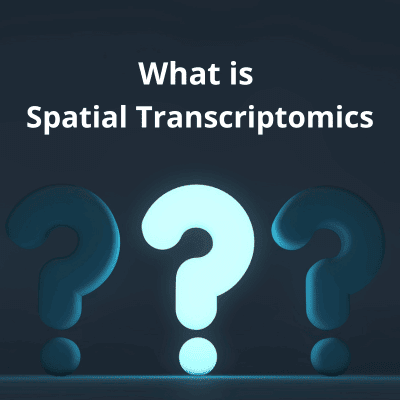What is Spatial Transcriptomics?
- 14th June 2023
- Posted by: Breige McBride
- Category: Gene Expression Analysis

Spatial transcriptomics refers to molecular profiling methods for transcriptome profiling which preserve the in situ spatial contexts of RNA molecules. Scientists can use these methods to measure all the gene activity in a tissue sample, including where the activity is occurring.1
What does spatial transcriptomics do?
Spatial transcriptomics addresses a problem present in single-cell RNA sequencing (scRNAseq). With scRNAseq, researchers can interrogate gene expression changes within cells. However, since single-cell sequencing separates cells from their original tissue, it prevents researchers from observing the full function of cells in their original tissue context.2 Fortunately, integrating spatial transcriptomics provides the spatial context that researchers lose when performing single-cell sequencing on its own. Therefore, we can use it to map where certain activities, such as gene activity, occur within a tissue.3
When was spatial transcriptomics invented?
Lundeberg, Frisen and Stahl invented ‘spatially resolved transcriptomics’ in 2016, at the KHL Royal Institute of Technology in Sweden.4 Then in 2020, Nature made it their Method of the Year. However, other techniques involving transcriptomes being read out by microscopy, either via fluorescence in situ hybridisation (FISH) or in situ sequencing, which have been around longer, can also be used to conduct spatially resolved transcriptomics studies. 5
How does spatial transcriptomics work?
A typical workflow for a study involving this type of transcriptomics generally begins with isolating and staining a section of tissue. After staining, the next step is to place the tissue section in contact with a slide of RNA-binding capture probes. Following this, the bound RNA will be barcoded and used to synthesise complementary DNA. This complementary DNA is then generated into libraries before being sequenced and the sequencing data generated can then be analysed and visualised. This analysis allows researchers to identify cell subpopulations and their gene expression patterns similar to scRNA-sequencing data analysis. Additionally, it provides information on the spatial organisation of these cell types that may indicate how different cell types interact with each other. Such analysis can also provide information about which parts of the tissue the genes of interest are expressed in. 6
You can view a more in-depth step-by-step workflow here.
Applications
Spatial information about the molecular characteristics of genes can provide information about the causes and effects of certain diseases. After all, diseases start when damage occurs in cells in the body as a result of infection. 7 So, it is unsurprising that being able to pinpoint which cells are expressing which genes in a particular area of tissue can reveal valuable insights to further medical research.
Some other applications include:
- Disease biomarker discovery
- Tumour heterogeneity analysis
- Furthering our understanding of brain function and neurological disorders
- Assisting with drug discovery and development
How is spatial transcriptomics used in drug discovery and development?
Spatial transcriptomics is particularly useful in drug discovery and development. For example, it can help with drug target identification and validation by revealing the spatial expression patterns of target genes and their interactions within tissues. Also, we can use it to assess the spatial impacts of drugs on gene expression. This can not only help to determine a drug’s mechanism of action, but it can also help researchers to determine if their drug has any toxic effects by revealing cellular responses to drug exposure.
Spatial Transcriptomics Data Analysis
As it grows in popularity, we are receiving more and more requests for this type of transcriptomics data analysis. In order to learn how we can assist with your particular project, please contact us. Our bioinformatics specialists are always happy to advise on the most suitable bioinformatics analyses for individual projects.
Author: Breige McBride, Content and Social Media Manager, Fios Genomics.
Reviewed by Fios Genomics Bioinformatics Experts to ensure accuracy
See also:
Bioinformatics and the Pharmaceutical Industry
Using Biobank Data to Reach Your Research Goals
An Introduction to Spatial Transcriptomics for Biomedical Research
The Clinical Trial Diversity Problem
Leave a Reply
You must be logged in to post a comment.

